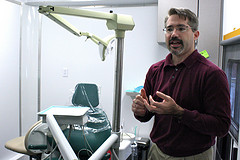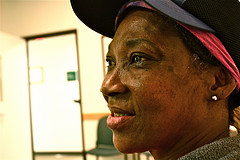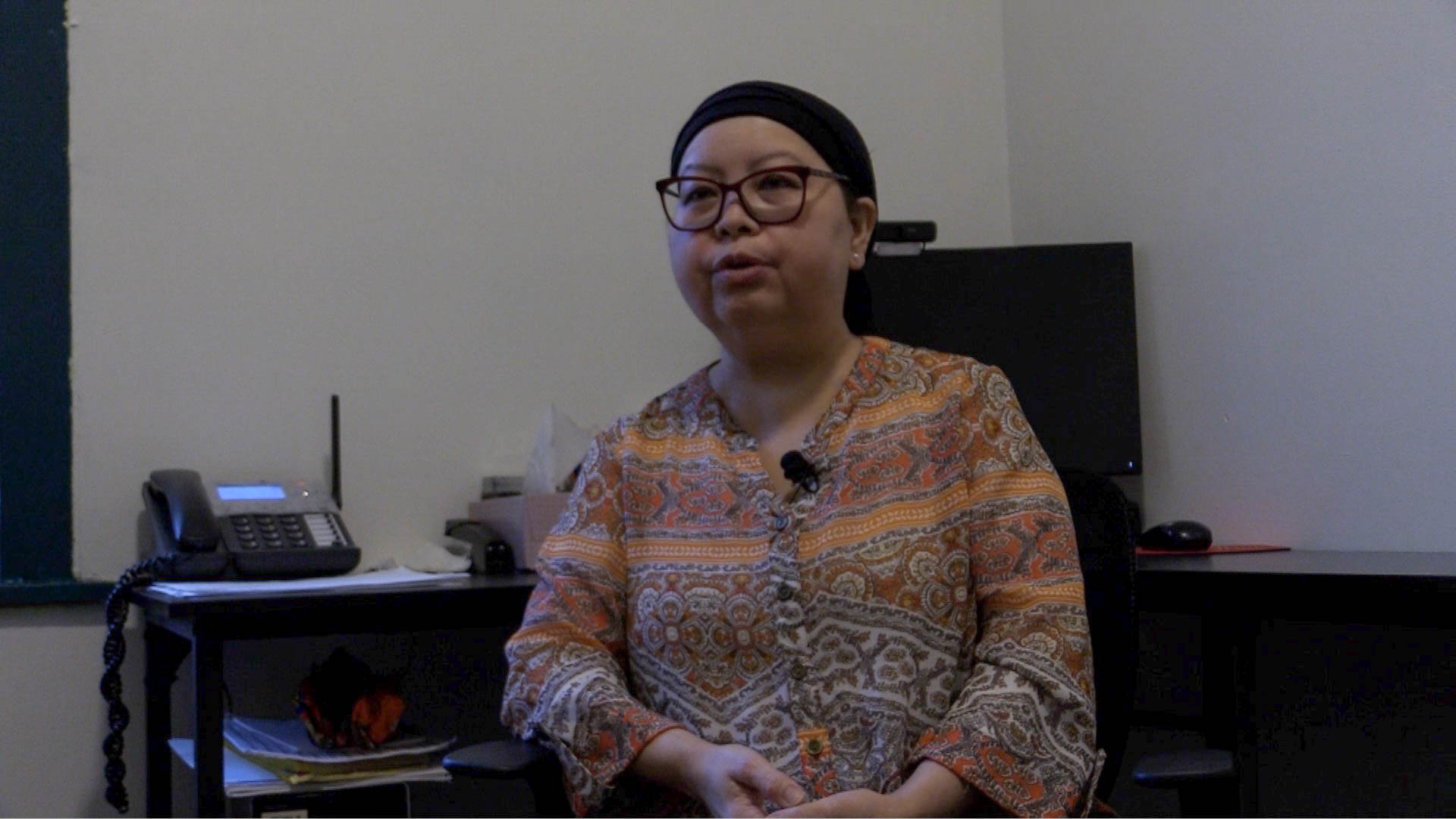
Carol Burnett, 38, stands in front of Covenant Care's mobile dentistry unit at Crossroads homeless shelter in southwest Detroit. An unemployed, uninsured mother of four, Burnett lives in the neighborhood and came to Crossroads hoping for help with her teeth, two of which are visibly loose, and a third which has already fallen out. Photo by Meredith Bennett-Smith
Darryl Fountain is soft-spoken, diabetic and good at making car bumpers. At least, he was good at it. Fountain received his pink slip this June, and now as the clock begins to wind down on his unemployment benefits, the 46 year-old has been left scrambling to find a way to manage an expensive and life-threatening disease.
Flanked by his mother and sister-in-law in the grey plastic chairs of the St. Francis Cabrini Clinic waiting room, Fountain speaks so quietly he’s almost impossible to hear. Probably too old, he said, to find further employment in the auto industry, Fountain has a specialized manufacturing skill set and few prospects. Cabrini Clinic, a free primary care clinic located in Southwestern Detroit, has become a lifeline, helping Fountain keep track of his many medications, making sure his prescriptions are filled on time and that his blood sugar is monitored. The risk of death for people with diabetes is about twice that of people without it.
It’s a familiar story—hospitalized twice since losing his job and insurance, Fountain has already reached a federal insurance assistance cap. Despite what his sister described as borderline mental deficiencies, he also won’t qualify for disability benefits.
“Medicaid has cut so many—you have to have kids now, or be disabled—and they don’t want to help people like Darryl,” said Angela Anderson, Fountain’s sister-in-law. “What do you do? You’re not really able to work; you have no insurance and no income. What do you do?”
This is the face of Detroit’s newly uninsured, a population who’s growing numbers are swelling the ranks of an uninsured community that has already far outstripped resources in a city that over the past 15 years has lost 60 percent of its primary care physician capacity, has no public hospital, and seemed on the brink of financial catastrophe as recently as 2008. Buffeted by sustained economic collapse and an unemployment rate hovering around 13 percent, a fundamental lack of adequate health care is simply another in a long list of societal inequities.
Left to their own devices, the lucky ones like Fountain may be able to make contact with clinics like Cabrini. Others, like Dwanna Myree, get creative. Myree, a 39 year-old mother of three was diagnosed with Multiple Sclerosis in 1996. A former payroll officer, Myree lost her job and her insurance three years ago. With MS medication running close to $1000 a month, Myree found inspiration in an episode of the Montel Williams show. Williams, who also has MS, told viewers to reach out directly to drug companies. Myree made the call, and now receives shipments of medication for free through an organization called MSLifelines.com.
Always on the lookout for free promotions offered by area eye doctors and other specialists, Myree struggles to pay for essential neurologists visits out of pocket, juggling bills and her unemployment allowance, while continuing to advocate for her still-pending disability. Her benefits will run out in June of 2012.
“I have to fight, and it takes everything out of you,” she said. “I guess I just learned to maneuver just enough tot get by.”
In an attempt to alleviate some of the stresses felt by individuals such as Myree, the community is starting to fight back, too. Recognizing their city’s dire need for comprehensive primary care, physicians, federally qualified health centers (FQHCs) and other community clinics have pieced together a safety net of sort in an effort to create medical homes for Detroit’s vulnerable underinsured and uninsured population.
Sister Mary Ellen Howard has been taking care of the uninsured in Detroit for decades, first as a nurse, then as a hospital adminstrator. Eight years ago Howard took the position of executive director at the Cabrini Clinic, where she is ideally placed to observe trends in the community. And what she sees now is worrying.
“I would say historically the people we’ve seen at Cabrini grew up in the welfare system,” Howard said. “They were born into poverty and they know how the welfare system works. The people we’re seeing the last couple of years do not fit that description. They did not grow up in poverty, but have recently lost their jobs, lost their homes, lost their insurance.”
For these people, seeking out advice and free medical care can be confusing, laborious, and embarrassing. “They don’t know where to go for help, they haven’t got a clue,” Howard said. “And in fact they take a lot more of our time and resources because they don’t want to ask for help, they don’t know how to get their utilities back on. They do not know how to work the system. When they go to the Department of Human Services and they tell them they’re not eligible for Medicaid, they believe them.”
Founded in 1950 by Most Holy Trinity Church, the Cabrini Clinic is the oldest free clinic in the country, said Howard, a 68-year-old retired nurse and passionate health care advocate who shows no sign of slowing down. The modest redbrick building sits on a shaded cul-de-sac, within sight of the newly neon-lit high rises of Woodward Avenue. But a revitalizing downtown does little to comfort the veteran clinician.
“Its pretty frightening,” she said. “I think this pattern is going to continue. There’s a real trend in our state and federal government to make of the victim a perpetrator: poor people are to blame; they’re causing the problem. “
Almost 40 million people living in the U.S. today do not have health insurance. In 2009, 164,000 of those uninsured lived in Detroit. Two years later, clinic directors like Howard put that number in the 200,000 range—around 22 percent of the city’s population. In New York City close to 14 percent of the population is uninsured. In Philadelphia it’s closer to 15 percent, and in Chicago 19.5 percent. The national average is 13 percent. The uninsured are three times as likely to go to the emergency room, and to be much sicker when they get there. They also are more likely to live with preventable diseases, and to develop depression.
Cabrini Clinic sees about 150 patients a week. Those who get appointments benefit from a dedicated volunteer staff that includes over one hundred doctors, nurses, pharmacists and social workers. It is a highly effective, total package system that typifies the concept of comprehensive care—the opposite of a one-time stopover in the local ER. But the high quality of the care also limits its volume.

Covenant Community Care's executive director Paul Propson stands in front of a dentist's chair in the mobile dental unit, which was parked in front of Crossroads, a local homeless shelter.Photo by Meredith Bennett-Smith
Further southwest, Covenant Community Care director Paul Propson prefers a different metaphor to describe some of the problems plaguing Detroit’s underserved population.
“It’s less of a safety net and more of a desert with a few oasis,” Propson said. “Hundreds of thousands of people are looking for these oasis. Many of them assume no one will help them. So they sit at home getting sicker and sicker until they have to go to the emergency room.”
Covenant, one of Detroit’s four FQHCs, has three clinics, two mobile trailers—one medical and one dental—and a school clinic. Unlike Cabrini, Propson also employs a staff that includes seven full-time doctors, three full-time dentists and three full-time nurses. Through a combination of very low patient contributions, grants and private donations, Covenant sees about 10,000 patients a year, 7,000 of them uninsured, and turns no one away.
“One myth we hear a lot is all poor people have Medicaid,” Propson said. “Some people have Medicaid. Our patients don’t generally qualify for it. They’re adults, and unless you’re disabled, you’re probably not going to get it.”
Chronic diseases like obesity, diabetes and hypertension are prevalent.
“These are high cost diseases they are not equipped to handle if they’re unemployed, or working a minimum wage job,” he said. “There’s no way they are not going to die from complications.”
Like other veterans of Detroit’s health care system, Propson is continually working to bring together resources and create partnerships and organizations in order to tighten the so-called safety net neighborhood by neighborhood, community by community.
On a recent rainy afternoon, Propson followed the center’s mobile dentistry unit to Crossroads homeless shelter, where Covenant donates free dental services.
“There is a lot of value in finding out what’s wrong,” Propson said. “We’ve identified cancers during check-ups.”
The units also serve an outreach purpose, identifying people outside of the medical system and attempting to find them a viable, sustainable base for primary care.
Carol Burnett is a vivacious mother of four who’s bright smile displays a missing bottom tooth. Smiling shyly, she reaches up to tug on a second upper tooth that wiggles obligingly. A second tooth on the bottom is also loose. If not for the mobile unit, she “would have let these go, yes I would have to tell you the truth. I’ll sit in that chair until they make me get out of it.”
Burnett lives in the area and frequents Crossroads for help with food and clothing. The shelter also spends $50,000 a year—the largest slice of its budget—on client prescriptions. In May Burnett badly fractured the bones in her leg and hip, requiring a trip to the emergency room and frustrating her search for work. Unemployed and uninsured, Burnett lives off of the $200 dollars a month she receives in subsidies for the two children still living at home, as well as whatever money her boyfriend, a racetrack horse groomer, can send home.
Burnett is the type of patient Propson hopes the mobile unit and shelter volunteers will be able to draw into the safety net. Wary of false promises, Burnett has never reached out to free clinics in her area, and views the emergency room as her only option for medical attention.
The use of ER’s as a substitute for preventative primary care creates a lose-lose situation, said Dr. Michael Kobernick, director of emergency services at St. John Providence, one of the city’s largest health systems. “All emergency departments see a lot of uncompensated care,” Kobernick said. This puts stresses on the hospital, as well as the patient—for whom the bill will eventually be due.
But the problem is not simply a financial one. Emergency room physicians are trained to think in a short-term capacity. It is their job to save lives, not ensure their patient’s quality of life for the next decade. Patients seen in ERs are getting “episodic, not primary care,” Kobernick said. “The problem is when they get only episodic care, they have to wait for something very bad to happen” before seeking treatment. For example patients with high blood pressure may wait for a stroke. “The rates of dangerous and or fatal side effects go way up,” he said.
Kobernick also volunteers his time with a group of doctors called Physicians Who Care, a group that works to shore up the holes in primary care of the uninsured.
Primary care resources have been hit especially hard in Detroit because of population loss. The number of practicing doctors is generally proportionate to the number of insured patients in a city. In Detroit, the insured population has declined, or held steady, while the number of uninsured patients continues to climb–increasing the need for volunteers like Kobernick to keep pace with the rising demands of the uninsured.
Propson offers a simple solution. “People need to be more passionate about caring for the uninsured then they are about making money,” he said. “We, as Detroitians, have the resources to see everyone. And we all need to give a little more.”
Across the street from Crossroads and the mobile dentistry unit, the bright blue banner of a private dentist strikes Propson as maddeningly ironic. “That’s the mystery and the tragedy of health care,” Propson said. “He feels he can’t help them, they feel they can’t go to his door.”
Back in the Cabrini Clinic’s cool emerald waiting room, the crowd has thinned as five o’clock melts into six, seven, eight o’clock. The volunteer staff, still cheerful after four hours on their feet call in the last prescriptions to the pharmacy team.
Veronica Green is one of the last to be seen. Petite, cheerful and missing her top teeth, Green is unemployed at 53, with five grown children and a weekly allowance of food stamps. Her Medicaid ran out years ago, although she’s not sure why. One day she went fill out her forms and they told her coverage had simply run out.
A long-time patient at Cabrini, Green feels safe here, and dutifully meets her monthly appointments for refills of Zantac—an acid reflux medication—and vitamins. The six pills a day “make me stronger, they make me want to eat. Otherwise I feel rundown,” she said.

Veronica Green, 53, waits for her medications at the Cabrini Clinic in southwest Detroit, a free health care provider. Unemployed and uninsured for over a decade, Green relies on food stamps to live. Photo by Meredith Bennett-Smith
It had started to rain. Fountain fussed over his elderly mother’s socks, making sure she was warm enough. In order for the safety net to ensure long term protection for patients like Fountain and Green, the system will need to include a coordinated , integrated system of care, Propson said, that will cut down on the inevitable waste of patchwork, incremental programs.Voices of Detroit Initiative (VODI) has been developing a virtual network along these lines, but so far have run into problems due to a lack of funding. “If the Affordable Care Act works, more people will get on Medicaid, and the insurance money will help Covenant expand,” Propson said. But “the fog is thick, and there are always going to be people who slip through the cracks, even if ACA works,” he added.
Like Green, Fountain feels safe at Cabrini. “They treat the patients good,” he said.
“Everybody likes it—you can tell from the atmosphere.”
Angela Anderson examined her bright-orange nail tips. If her city had been slowly deteriorating before, “now, it’s really bad.” Without Cabrini, her brother-in-law would have no way to pay for his meds, and no resources if his disease becomes suddenly aggressive.
“I’m here for support,” she said, watching her brother-in-law out of the corner of her eye. “This place, it’s a big help.”

Comments
Excellent narrative Meredith! Congratulations and thanks for writing about it.
[…] more here: Rebuilding Detroit: Community clinics build a … – Pavement Pieces This entry was posted in Family & Community and tagged city, create-medical, health-centers, […]
[…] and shot stories on a visit by President Barack Obama, Detroit’s homicide rate, tech initiatives, community clinics, urban farming and […]
[…] Member Sister Mary Ellen Howard, Executive Director of the St. Frances Cabrini Clinic in Detroit, MI has her work cut out for her for the next 18 months: she was selected by the […]